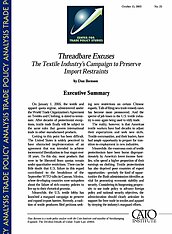Getting to this point has been difficult. The United States is widely perceived to have obstructed implementation of an agreement that was intended to achieve incremental liberalization in four stages over 10 years. To this day, most products that were to be liberated from quotas remain under quantitative restrictions. There can be little doubt that U.S. failure in this regard contributed to the breakdown of the September WTO talks in Cancun, Mexico, where developing countries were outspoken about the failure of rich-country policies to live up to their rhetorical promise.
Meanwhile, the U.S. textile lobby has launched a rearguard campaign to preserve and expand import barriers. Recently, a coalition of textile producers filed petitions seeking new restrictions on certain Chinese exports. Talk of filing new trade remedy cases has become more pronounced. And the specter of job losses in the U.S. textile industry is once again being used to vilify trade.
The reality, however, is that American textile workers have had decades to adjust their expectations and seek new skills. Textile communities, and their leaders, have had ample opportunity to prepare for transition to employment in new industries.
Meanwhile, the enormous costs of textile protectionism have been borne disproportionately by America’s lower-income families, who spend a higher proportion of their earnings on clothing. Textile protectionism has also deprived poor countries of export opportunities-precisely the kind of opportunities the Bush administration identifies as vital for promoting economic stability and security. Considering its burgeoning propensity to use trade policy to advance foreign policy and national security objectives, the administration should clearly articulate its support for freer trade in textiles and apparel by denying the industry’s rearguard efforts.


